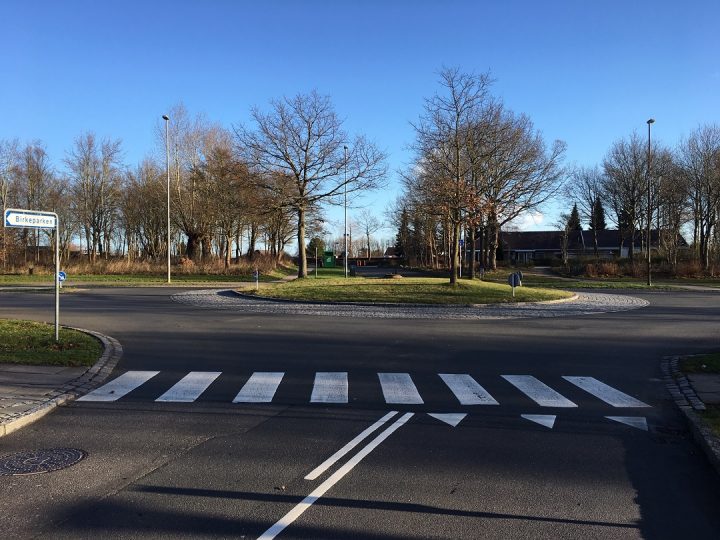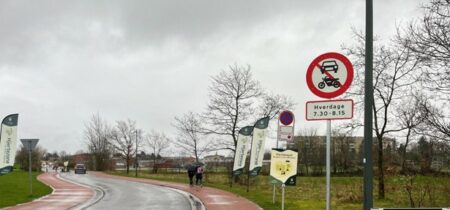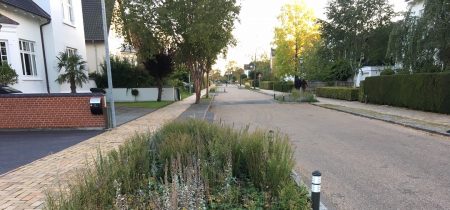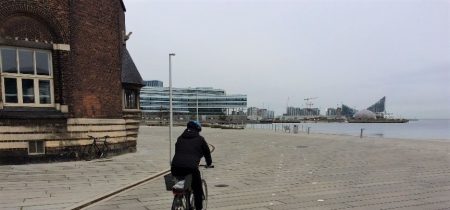Roundabouts
Roundabouts can be designed in many different shapes and sizes. Apart from the difference in cost, the design is largely determined by traffic volume and speed. Cycle tracks are only necessary in large roundabouts. Sometimes it’s best for cyclists to bypass the roundabout entirely.
By Troels Andersen, Odense municipality
Roundabouts are often used to improve traffic safety in Denmark, in urban as well as rural areas. Roundabouts can also be used to calm traffic and improve traffic flows when they replace signal controlled intersections. The risk of left- turn accidents and cross collisions is eliminated in roundabouts.
However, roundabouts do not always reduce the number of cycling accidents. On the contrary, all Danish and foreign studies show that roundabout construction increases the number of cycling accidents, and the accidents are no less serious. Roundabouts are especially difficult to navigate for the visually impaired. The majority of cycling accidents involves entering vehicles.
Roundabouts can be designed with one or more lanes in the circulation area and the entrances and exits. Bicycle traffic is not recommended in a roundabout if there is more than one lane in the circulation area and the entrance and exit. Bicycle traffic should then bypass the roundabout. Denmark has no experience with signal controlled roundabouts.
Two-way cycle tracks close to the circulation area where motor vehicles are required to yield are not safe since drivers often think that all traffic in the roundabout is one-way.
Entering traffic lane should generally be no wider than 3.5 m and preferably narrower in small and medium size roundabouts. Exit lanes should be no wider than 4 m. Truck aprons in chaussée stones around the central island can make it easier for trucks and busses to navigate, but may also mean higher speeds through the roundabout.
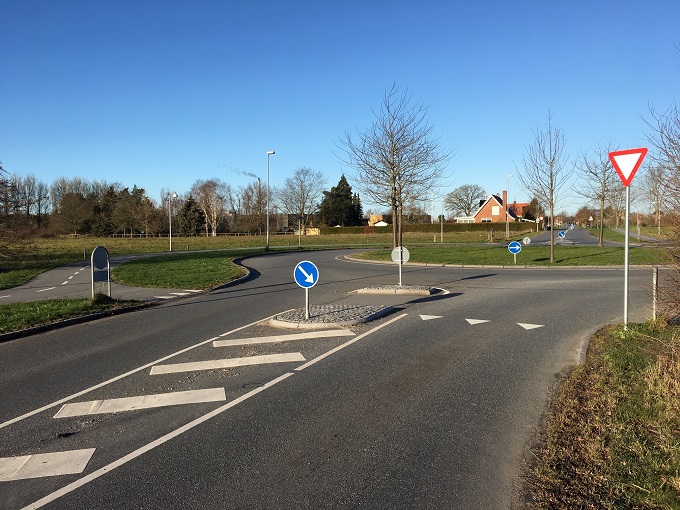
- In rural areas a two-way cycle track circling the roundabout is often chosen. Cyclists are required to yield at all side roads, but are allowed to circle the entire roundabout in both directions. Photo: Troels Andersen
Roundabouts in open country
Roundabouts in open country are normally relatively dynamic, i.e. circulating cars can drive relatively fast. This is possible with a large central island 20 – 40 m in diameter and triangular or trumpet shaped traffic islands in the roundabout’s legs.
Cyclists should not cycle in dynamic roundabouts. Cyclists should use a bypass track around 10-30 m from the circulation area instead, and be required to yield to motor traffic when crossing the road.
The cycle track can be made two-way in order to shorten the cyclist’s deviation route. Another solution is a cyclist tunnel under the roundabout, which is an excellent idea on heavily trafficked roads with four or six lanes.
Cyclists may cycle in smaller, dynamic roundabouts with a central island 10-20 m in diameter and parallel or small triangular islands in the roundabout’s legs. It is important that cyclists can circle the roundabout on a one-way cycle track and there should be a cycle track entering and exiting the roundabout.
The cycle track and traffic islands in less dynamic roundabouts should be designed to calm traffic. It is standard practice in Denmark to establish one-way cycle tracks in the circulation area.
There is no collected data in Denmark on one-way cycle tracks 3-7 m away from the circulation area. Swedish, German and Dutch experience indicates that a verge of approx. 5 m between the cycle track and the circulation area is safest. The cycle track should be one- way and cars should be required to yield to cyclists.
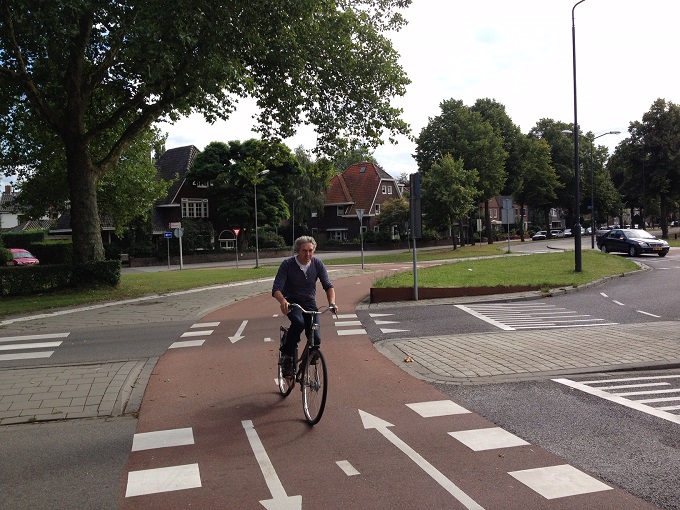
- This Dutch roundabout with set-back cycle track and where motor traffic is required to yield may be worth testing, but not with two-way bicycle traffic. Photo: Troels Andersen
Urban roundabouts
Road traffic speed in cities is generally lower than in rural areas. Consequently roundabouts in cities are normally smaller than in rural areas and are significantly more traffic calming. There are more light road users in cities, and this should be the starting point for the design.

- Cars can drive fast here. Notice the cycle slip lane on the right.
The maximum capacity is 25,000 cars over a 24 hour period in a single lane roundabout and 40,000 in a dual lane. Design and traffic composition can reduce capacity. Large volumes of left- turning cars reduce capacity.
Establishing cycle lanes in roundabouts should be approached with caution since a cycle lane makes it necessary to widen the circulation area, which encourages drivers to drive faster. Furthermore, cyclists risk being squeezed entering and exiting when there is no physical separation.
In areas with light traffic roundabouts on roads with a 30-50 km/h speed limit, cyclists and cars should be mixed in the one-lane circulation area. This type of roundabout should be very traffic calming. The central island should only be 10 m in diameter and there should be no islands in the legs. It might be worth considering establishing the entire roundabout on a raised surface.
In large roundabouts with a central island 15-20 m in diameter, it’s probably best to establish a one-way cycle track at a distance of approx. 5 m from the one lane circulation area. However there is not enough statistical material to document this. Care must be taken to ensure that there can be no doubt as to right of way.
If there’s not enough space for a cycle track in roundabouts with less than 8,000 vehicles over a 24 hour period, it may be a good idea to establish the circulation area without cycling facilities or with a cycle lane and a narrow motor traffic circulation area. When there is a greater traffic volume but very little space a smaller central island or traffic light control might be a good idea.
At even larger roundabouts with a central island of 20-30 m in diameter, the traffic volume is usually so great and the motor speed so high that cyclists should not be mixed with motor traffic at all.
At roundabouts with one lane in the circulation area and in the entrances and exits, a one-way cycle track should be established 5-7 m from the circulation area. It’s worth considering installing this type of cycle track on a raised surface. Once again, the right of way rules must be absolutely clear.
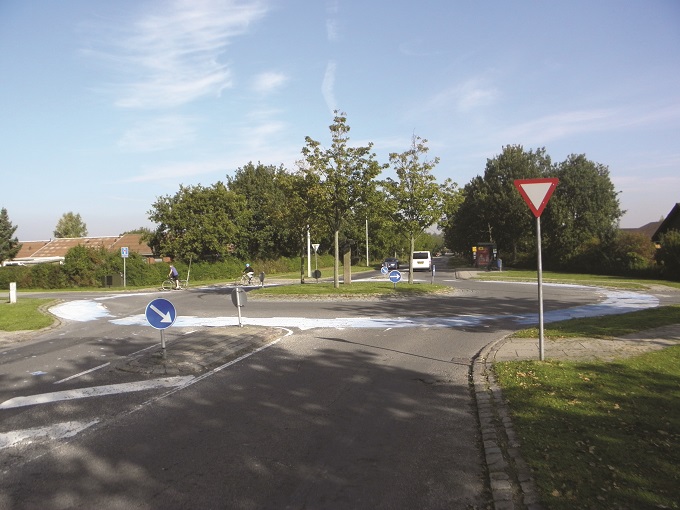
- A roundabout with an inexpedient cycle lane. Photo: Troels Andersen
Mini-roundabouts
The central island in a mini-roundabout can be driven on. The capacity of a mini-roundabout is up to 15,000 cars per 24 hour period. Mini-roundabouts are used when the signed speed limit is 30-50 km/h. A mini-roundabout costs merely one tenth of a standard roundabout and the diameter of the circulation area is only 15-25 m. It’s a good idea to establish a mini-roundabout as part of a traffic renovation plan in an urban area or a new road. Mini-roundabouts are not suitable for heavy vehicles, for example bus routes. This is because the bus or the truck fills the entire mini-roundabout and blocks the mini-roundabout for several seconds. Duty to yield must be clearly marked in the mini-roundabout. There may be safety benefits in raising the surface.
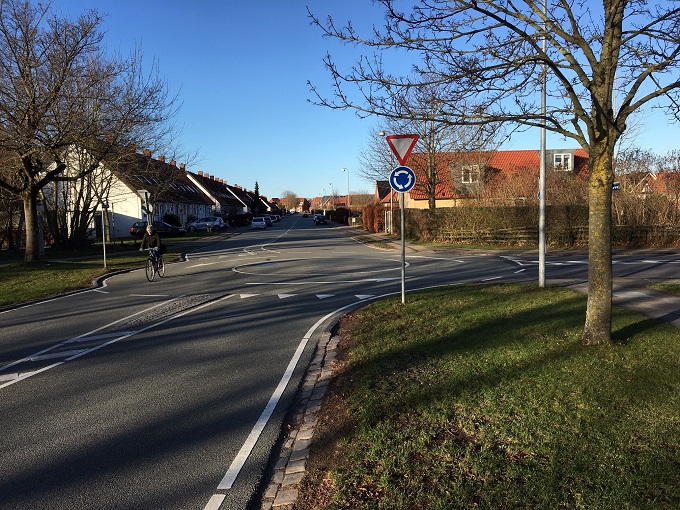
- A mini-roundabout is good for bicycle traffic. Photo Troels Andersen
In mini-roundabouts with little traffic cyclists should be mixed with cars in the circulation area. The mini-roundabout should be very traffic calming.
In mini-roundabouts with more than 6,000 – 8,000 cars over a 24 hour period a one-way cycle track should be established, which should probably be laid down approx. 5 meters from the circulation area.
Sources
Brüde, Ulf og Larsson, Jörgen (1996): The safety of cyclists at roundabouts, VTI meddelande 810A, Sverige.
CROW (1998): Eenhein in rotondes, Publikatie 126, Holland.
Fietsersbond enfb (1999): Fietsvriendelijke rotondes, Holland.
Haller, Wolfgang; Lange, Johannes; Dankmar, Alrutz og Stellmacher-Hein, Jörg (1999): Verkehrssicherheit
von Fussgängern und Radfahrern an kleinen Kreisverkehrsplätzen, Strassenverkehrstechnik 10/99, pp. 496-502, Tyskland.


